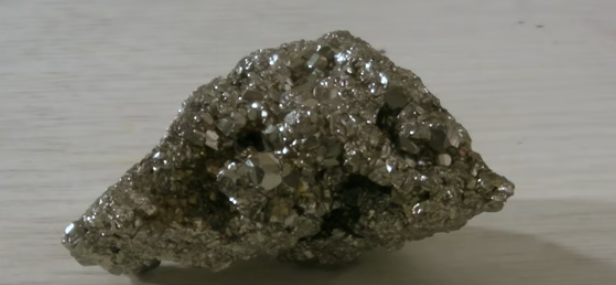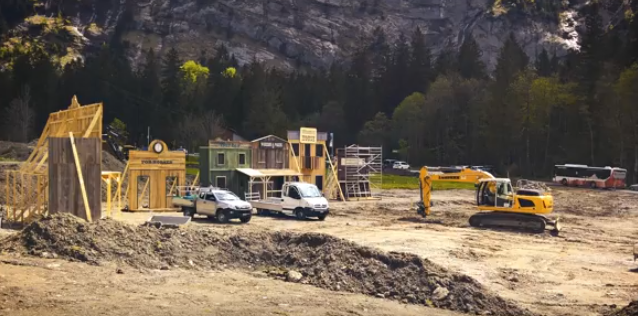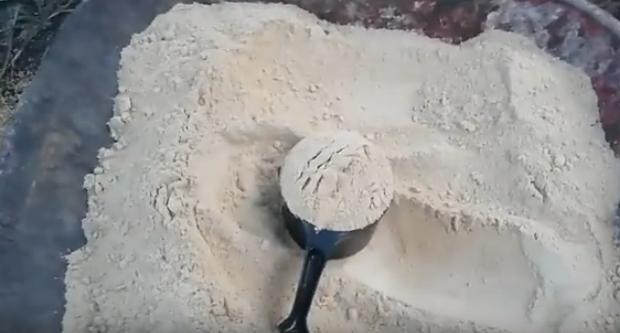Dolomite is a unique mineral. Even stones that are recovered in the same deposit can have completely different colors. A broad color spectrum and excellent technical parameters allow the use of dolomite in several areas.
1. The formula and properties of the mineral.
2. Production.
3. Application of dolomite.
4. Advantages and disadvantages.
1. The formula and properties of the mineral.
 |
| A piece of dolomite |
Dolomite is a carbonate of magnesium and calcium. Its formula is CaCO3 · MgCO3. The current composition is almost completely compatible with the theoretical composition. It usually contains about 45% carbon dioxide, 30% calcium oxide and 20% magnesium oxide. It can also contain impurities of iron, potassium and other metals. He got his name with the name of the discoverer - the French D. Dolomier.
The grinding of the rock in powder form and drying under production conditions leads to dolomite flour. It is divided into 4 classes, in which 3 brands are awarded.
The mineral hardness is about 3.5-4. The density is 2.85 to 3.0 g / cm3. The mineral is long lasting but quite fragile. It is easy to scratch with a steel needle.
Dolomite is chemically similar to calcite. It is characterized by a more intense brilliance and a mediocre solubility. Finally, dolomite can only be distinguished by specific limestone chemical tests.
Hydrochloric acid is used in the field to distinguish these two minerals. A small piece is placed on a glass surface and then drops of hydrochloric acid. When the substance boils and carbon dioxide is released, the mineral found is calcite. Dolomite interacts with hydrochloric acid is not as active.
There are different types of dolomite, which differ due to their different natural characteristics. Minerals can be mounted, coarse, accumulated, transparent, marble, etc. They can have a gray, white or pale yellow color. There are fewer black stones. On faces is a frosted, pearly or glassy glow.
A characteristic of dolomite is the presence of colored spots on its surface. You can switch from one sound to another or be separate.
2. Production.
 |
| Dolomite can be produced on a large scale for various needs |
Since dolomite is a sedimentary rock, its thickness is determined by its depth. The deeper the mineral layer is, the stronger it is.
The deposits of dolomite are located in Switzerland, in Spain and on the North American continent. The most important are in Mexico and the Lake Ontario area. It is also found in the Caucasus, the Moscow region, the Urals and Central Asia.
The extraction of dolomite occurs in the quarries by drilling and blasting or by using well loads. The treatment includes crushing, roasting and, in some cases, grinding. The material is crushed with hammers or jaw crushers. Dolomite is usually burned in well furnaces with distant stoves. For grinding with trunks or other mills.
When cooking at different temperatures different materials are obtained. The calcination of etch dolomite is carried out at temperatures of up to 750 degrees. Dolomite cement is formed at higher temperatures (up to 850 degrees). Dolomitic, extinguishable lime occurs at a temperature of about 950 degrees.
The dolomite flour is obtained by grinding and fine grinding of raw materials, in its composition the usual dolomite.
For its production this equipment is required:
- Crushing plant;
- A mill or crusher to grind the rocks;
- Power-vibration mechanism;
- Vibrating screen
3. Application of dolomite.
 |
| In nature, dolomite is no less than calcium. The size of these minerals is almost identical. |
- For the production of refractory materials instead of magnesite;
- For the production of magnesium metal;
- In steel production;
- As a raw material for flows in the metallurgical industry;
- For the production of building materials such as mineral wool, magnesia cement, sovelite, etc.
- As a coating and coating material in the construction of houses and industrial types;
- When laying roads;
- Increase the strength and chemical resistance of the glass;
- For the production of rubber;
- As a filling when receiving paper;
- As an abrasive for polishing metal and glass surfaces;
- As a raw material for the production of porcelain enamels;
- As a means of controlling various insects;
- An landscaping.
The simple workmanship determines the popularity of this stone among the construction workers. It can be given any shape, forming a flat or raised surface. It has good strength and is therefore used as cladding material for walls, window frames and stairs. The arrangement of floors in shopping malls and other public spaces is important.
The dolomite plate has filter qualities and allows you a favorable micro climate in the room. Stone tiles are used for the finishing of baseboards and facades. Glazed tiles are usually covered with a floor. Polished tiles are very suitable for interior decoration. For paving, beams with anti-slip properties are used.
It is used to decorate fountains, swimming pools, fireplaces and stoves and to restore palaces. Using original polishing techniques, designers create products that look like natural marble.
Dolomite flour is an ingredient in dry construction mixtures. The grains of this mineral have a cubic shape and offer better adhesion than the sand. Therefore, dolomite powder is very popular in Russian companies. The mixtures with their addition are of the highest quality.
In addition, dolomitic flour is used to make a variety of sealants, sealants, in the manufacture of paints, linoleum, etc. Another field of application is the descaling, loosening and fertilizing of the soil. It reduces the acidity of the soil and enriches it with magnesium and potassium. It can be used outdoors as well as for greenhouses and greenhouses.
Dolomite has been producing dishes recently. Dolomite ceramic is not expensive, it has a beautiful appearance and is characterized by its low weight, but at the same time is very fragile. Under the influence of high temperature, the outer layer breaks and micro cracks form.
It is therefore not recommended to eat hot dishes from Dolomites dishes. Some scientists argue that dolomite is generally not suitable for the manufacture of crockery because it is sensitive to the action of acids, including coal. This material is not harmful to health.
4. Advantages and disadvantages.
 |
| Dolomite is characterized by the best properties of natural stone. It is durable, frost resistant and has an unusual texture. |
- Plastic;
- Low thermal conductivity;
- High strength;
- Respect for the environment;
- High aesthetics;
- Possibility of combination with any finishing material;
- Possibility of application for external and internal work.






No comments:
Post a Comment